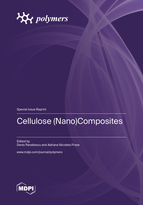Cellulose (Nano)Composites
A special issue of Polymers (ISSN 2073-4360). This special issue belongs to the section "Biomacromolecules, Biobased and Biodegradable Polymers".
Deadline for manuscript submissions: closed (12 April 2022) | Viewed by 47514
Special Issue Editors
Interests: biodegradable polymers; polymer nanocomposites with cellulose nanocrystals; cellulose nanofibers or bacterial nanocellulose; polymer composites with lignocellulosic fibers; thermal, mechanical and morphological characterization of polymer composites and nanocomposites
Special Issues, Collections and Topics in MDPI journals
Interests: isolation of nanocellulose from various sources; characterization of nanocellulose; cellulose nanomaterials; biodegradable polymers; polymer composites and nanocomposites; materials processing
Special Issues, Collections and Topics in MDPI journals
Special Issue Information
Dear Colleagues,
From the first publication on cellulose nanocomposites in the mid-90s, this topic has experienced an exponential growth. Many works have focused on the extraction of cellulose nanocrystals or nanowhiskers from different sources including biomass, on the defibrillation of cellulose fibers and biosynthesis of bacterial cellulose. Tremendous advancement was signaled in the understanding of nanocellulose properties, its behavior in various environments and in contact to polymers, other nanoparticles or compounds. Cellulose micro and nanomaterials as fibers, whiskers, films, coatings, hydrogels or sponges have been tested for different applications, from biomedicine and pharmacy to automobiles, paper making, electronics, food packaging or consumer goods. A special application of micro- and nanocelluloses is to improve the properties and biodegradability of thermoplastic or thermosetting polymers derived from fossil fuel or renewable sources. This special issue welcomes submissions of original papers, articles or reviews, in the field of cellulose (nano)composites including all type of cellulose containing materials with both micro and nano-cellulose fibers, or lignocellulosic fibers combined with natural or synthetic polymers, metal oxides or conductive polymers. The aim is to advance in the understanding of fundamental and technological aspects for better product development and application.
Dr. Denis Mihaela Panaitescu
Dr. Adriana Nicoleta Frone
Guest Editors
Manuscript Submission Information
Manuscripts should be submitted online at www.mdpi.com by registering and logging in to this website. Once you are registered, click here to go to the submission form. Manuscripts can be submitted until the deadline. All submissions that pass pre-check are peer-reviewed. Accepted papers will be published continuously in the journal (as soon as accepted) and will be listed together on the special issue website. Research articles, review articles as well as short communications are invited. For planned papers, a title and short abstract (about 100 words) can be sent to the Editorial Office for announcement on this website.
Submitted manuscripts should not have been published previously, nor be under consideration for publication elsewhere (except conference proceedings papers). All manuscripts are thoroughly refereed through a single-blind peer-review process. A guide for authors and other relevant information for submission of manuscripts is available on the Instructions for Authors page. Polymers is an international peer-reviewed open access semimonthly journal published by MDPI.
Please visit the Instructions for Authors page before submitting a manuscript. The Article Processing Charge (APC) for publication in this open access journal is 2700 CHF (Swiss Francs). Submitted papers should be well formatted and use good English. Authors may use MDPI's English editing service prior to publication or during author revisions.
Keywords
- polymer composites
- nanocomposites
- cellulose nanocrystals
- nanofibrillated cellulose
- lignocellulosic fibers
- biodegradability
- aerogels
- smart materials
- hybrid composites
- conductive composites
- biosorbents
- drug-delivery systems







